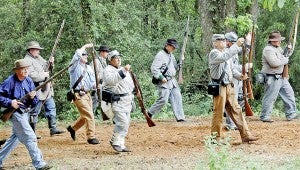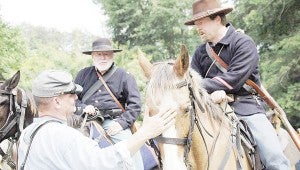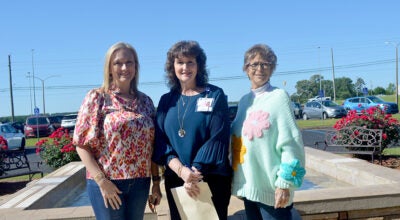HISTORY COMES ALIVE: The Pioneer Museum hosts ambush re-enactment
Published 2:00 am Saturday, May 23, 2015

The Pioneer Museum of Alabama was the site of the re-enactment of the “Ambush at Hobdy’s Bridge.” The re-enactment acknowledged the 150th anniversary of the historic event that took place at Hobdy’s Bridge that spanned the Pea River between Pike and Barbour counties. May 19, 1865, soldiers of the First Florida Cavalry (Union) were ambushed by Confederate stragglers while crossing Hobdy’s Bridge. Pictured: Members of the Phillips Legion Cavalry, 53rd Alabama Cavalry re-enacted the Confederate charge.
The re-enactment of the “Ambush at Hobdy’s Bridge at the Pioneer Museum of Alabama last weekend shed new light on a historical event that happened in Pike County and etched Hobdy’s Bridge deeper into the saga of the South in both the Creek War of 1836 and the War Between the States.
“In the eyes of the government, the Creek War of 1836 had been over for months when one of its largest battles was fought on the Pea River at Hobdy’s Bridge,” said Bob McLendon, commander of the Phillips Legion Cavalry, 53rd Alabama Cavalry that re-enacted “the Ambush.”
For generations, Pike and Barbour counties claimed the bridge, which spanned the Pea River between the two counties, was the last battle of the Creek War of 1836. However, Geneva and Dale counties contend that battles in their counties were the last battles of the war.
Hobdy’s Bridge was also at the center of another “last of the war” claim.
For a time, historians stated that the last casualties of the Civil War were sustained at Palmitto Ranch in Texas on May 13, 1865. Further research found that the last casualties of the war actually took place six days later at Hobdy’s Bridge.
“After the formal surrender of the two main Confederate armies east of the Mississippi River, bands of former Confederate “guerillas” were roaming South Alabama,” McLendon said. “In response, the 1st Florida Cavalry (US) was sent to base out of Montgomery. On May 11, 1865, a detachment of 25 men of the 1st Florida was sent to escort mail from Montgomery to Eufaula. Some of the men were from the area so, when they reached Eufaula, Lt. Joseph Carroll gave them a short leave to go visit their families. He ordered the men to reunite with him at Hobdy’s Bridge on May 19.”

Bob McLendon, left, commanded the Union cavalry at the “Ambush at Hobdy’s Bridge re-enactment. Local re-enactors, McLendon and Joe Murphy, talked with Johnny Reb following the re-enactment. The young Reb wanted to know how two Southern gentlemen could ride against the Confederates. Murphy said, in re-enactments “somebody’s just got to do it.”
But, when Carroll learned that several bands of Confederate “guerillas” were active in the area, he headed back to Montgomery with the main body of the original detachment. The others were to follow when they returned from leave.
“On May 19, those who were left behind assembled at Hobdy’s Bridge on their route back to Montgomery,” McLendon said. “As they crossed the wooden bridge, they were ambushed by the Confederate guerillas. Corporal John W. Skinner, Company C, 1st Florida Cavalry (US), was killed in the ambush.”
Skinner, a native of Alabama, had originally been a Confederate soldier. He enlisted on February 14, 1863 in Company D, 57th Regiment Alabama Infantry, organized in Troy. He was discharged on Dec. 18, 1863. Records stated that Skinner was suffering from “confluent vanola followed by erysipelas of the leg.”
“Three Union soldiers were wounded in the ambush at Hobdy’s Bridge,” McLendon said. “They were identified as William Smith, Daniel V. Melvin and Nathan Mims. Smith was hospitalized in Montgomery for several weeks due to numerous gunshot wounds.
“When Smith first applied for a pension, his application was denied, stating the men were off duty. However, a review board reversed the ruling and determined that they were back on duty from the time they arrived at Hobdy’s Bridge on Carroll’s orders.”
As a result of the ambush at Hobdy’s Bridge, a former Alabama Confederate soldier, while serving in a Florida Union regiment in Alabama, is officially the last man killed in the Civil War, McLendon said.
“The re-enactment of the Ambush at Hobdy’s Bridge was a way to bring a historical event that happened in our own backyard to life,” McLendon said. “Too often people go on vacations to find places of interest and don’t pay attention to local history.”
Three other local Civil War re-enactors participated in the Ambush at Hobdy’s Bridge, Joe Murphy, Russell Johnson and David Scroggins.
“All of us have ancestors who were members of the 53rd Alabama Cavalry,” McLendon said. “David’s great-grandfather, James Scroggins, and my great-grandfather, Jonathan McLendon, were members of Company G. Joe’s great-grandfather, Alphie Tatom, and Russell’s direct ancestor, John Rushing, were members of Company B.
McLendon said re-enactors often have ancestors who served in their groups but that is not a requirement.
“Anyone who likes history and wants to be involved in bringing history to life would enjoy participating in a re-enactment group,” he said. “As re-enactors, we try to portray each event as authentically as we can, including the uniforms, weapons and the equipment. A cavalry unit is the most expensive because re-enactors must have a horse and a trailer.
“There’s no better way to learn about history and to appreciate it than to relive it.”
Anyone who is interested in knowing more about the 53rd Alabama Cavalry or other re-enactment groups is invited to call McLendon at 334-484-8562.



